Connectomics of the Octopus vulgaris vertical lobe provides insight into conserved and novel principles of a memory acquisition network
- PMID: 37410519
- PMCID: PMC10325715
- DOI: 10.7554/eLife.84257
Connectomics of the Octopus vulgaris vertical lobe provides insight into conserved and novel principles of a memory acquisition network
Abstract
Here, we present the first analysis of the connectome of a small volume of the Octopus vulgaris vertical lobe (VL), a brain structure mediating the acquisition of long-term memory in this behaviorally advanced mollusk. Serial section electron microscopy revealed new types of interneurons, cellular components of extensive modulatory systems, and multiple synaptic motifs. The sensory input to the VL is conveyed via~1.8 × 106 axons that sparsely innervate two parallel and interconnected feedforward networks formed by the two types of amacrine interneurons (AM), simple AMs (SAMs) and complex AMs (CAMs). SAMs make up 89.3% of the~25 × 106VL cells, each receiving a synaptic input from only a single input neuron on its non-bifurcating primary neurite, suggesting that each input neuron is represented in only~12 ± 3.4SAMs. This synaptic site is likely a 'memory site' as it is endowed with LTP. The CAMs, a newly described AM type, comprise 1.6% of the VL cells. Their bifurcating neurites integrate multiple inputs from the input axons and SAMs. While the SAM network appears to feedforward sparse 'memorizable' sensory representations to the VL output layer, the CAMs appear to monitor global activity and feedforward a balancing inhibition for 'sharpening' the stimulus-specific VL output. While sharing morphological and wiring features with circuits supporting associative learning in other animals, the VL has evolved a unique circuit that enables associative learning based on feedforward information flow.
Keywords: caphalopods; connectome; feedforward; invertebrate; learning; memory; neuroscience; octopus.
© 2023, Bidel, Meirovitch et al.
Conflict of interest statement
FB, YM, RS, XL, EP, FY, AP, YW, TS, DB, AS, JL, BH No competing interests declared
Figures



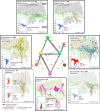





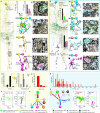

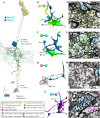




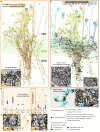
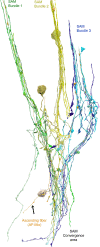


Update of
- doi: 10.1101/2022.10.03.510303
Similar articles
-
Cellular and synaptic organization of the Octopus vertical lobe.bioRxiv [Preprint]. 2025 Jan 29:2025.01.29.635406. doi: 10.1101/2025.01.29.635406. bioRxiv. 2025. PMID: 39975031 Free PMC article. Preprint.
-
Neurotransmission and neuromodulation systems in the learning and memory network of Octopus vulgaris.J Morphol. 2022 May;283(5):557-584. doi: 10.1002/jmor.21459. Epub 2022 Feb 8. J Morphol. 2022. PMID: 35107842 Free PMC article.
-
Serotonin is a facilitatory neuromodulator of synaptic transmission and "reinforces" long-term potentiation induction in the vertical lobe of Octopus vulgaris.Neuroscience. 2010 Aug 11;169(1):52-64. doi: 10.1016/j.neuroscience.2010.04.050. Epub 2010 Apr 28. Neuroscience. 2010. PMID: 20433903
-
Functional and comparative assessments of the octopus learning and memory system.Front Biosci (Schol Ed). 2010 Jan 1;2(2):764-71. doi: 10.2741/s99. Front Biosci (Schol Ed). 2010. PMID: 20036982 Review.
-
The vertical lobe of cephalopods: an attractive brain structure for understanding the evolution of advanced learning and memory systems.J Comp Physiol A Neuroethol Sens Neural Behav Physiol. 2015 Sep;201(9):947-56. doi: 10.1007/s00359-015-1023-6. Epub 2015 Jun 26. J Comp Physiol A Neuroethol Sens Neural Behav Physiol. 2015. PMID: 26113381 Review.
Cited by
-
The neural basis of visual processing and behavior in cephalopods.Curr Biol. 2023 Oct 23;33(20):R1106-R1118. doi: 10.1016/j.cub.2023.08.093. Curr Biol. 2023. PMID: 37875093 Free PMC article. Review.
-
Cellular and synaptic organization of the Octopus vertical lobe.bioRxiv [Preprint]. 2025 Jan 29:2025.01.29.635406. doi: 10.1101/2025.01.29.635406. bioRxiv. 2025. PMID: 39975031 Free PMC article. Preprint.
-
mEMbrain: an interactive deep learning MATLAB tool for connectomic segmentation on commodity desktops.Front Neural Circuits. 2023 Jun 15;17:952921. doi: 10.3389/fncir.2023.952921. eCollection 2023. Front Neural Circuits. 2023. PMID: 37396399 Free PMC article.
-
SmartEM: machine-learning guided electron microscopy.bioRxiv [Preprint]. 2025 May 15:2023.10.05.561103. doi: 10.1101/2023.10.05.561103. bioRxiv. 2025. PMID: 38915594 Free PMC article. Preprint.
-
NSF Workshop Report: Exploring Measurements and Interpretations of Intelligent Behaviors Across Animal Model Systems.J Comp Neurol. 2025 Mar;533(3):e70035. doi: 10.1002/cne.70035. J Comp Neurol. 2025. PMID: 40038068 Free PMC article.
References
-
- Bae JA, Baptiste M, Bishop CA, Bodor AL, Brittain D, Buchanan J, Bumbarger DJ, Castro MA, Celii B, Cobos E, Collman F, da Costa NM, Dorkenwald S, Elabbady L, Fahey PG, Fliss T, Froudarakis E, Gager J, Gamlin C, Gray-Roncal W, Halageri A, Hebditch J, Jia Z, Joyce E, Joyce J, Jordan C, Kapner D, Kemnitz N, Kinn S, Kitchell LM, Koolman S, Kuehner K, Lee K, Li K, Lu R, Macrina T, Mahalingam G, Matelsky J, McReynolds S, Miranda E, Mitchell E, Mondal SS, Moore M, Mu S, Muhammad T, Nehoran B, Ogedengbe O, Papadopoulos C, Papadopoulos S, Patel S, Pitkow X, Popovych S, Ramos A, Clay Reid R, Reimer J, Rivlin PK, Rose V, Schneider-Mizell CM, Seung HS, Silverman B, Silversmith W, Sterling A, Sinz FH, Smith CL, Suckow S, Takeno M, Tan ZH, Tolias AS, Torres R, Turner NL, Walker EY, Wang T, Wanner A, Wester BA, Williams G, Williams S, Willie K, Willie R, Wong W, Wu J, Xu C, Yang R, Yatsenko D, Ye F, Yin W, Young R, Yu S, Xenes D, Zhang C, The MICrONS Consortium Functional connectomics spanning multiple areas of mouse visual cortex. bioRxiv. 2021 doi: 10.1101/2021.07.28.454025. - DOI
MeSH terms
Grants and funding
LinkOut - more resources
Full Text Sources

